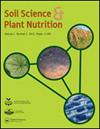日本农牧混作系统中常规稻草循环利用与牛粪堆肥对稻田钾平衡的影响
IF 1.8
4区 农林科学
Q3 ENVIRONMENTAL SCIENCES
引用次数: 2
摘要
在观察到负钾平衡的发展中国家,水稻生产中的钾(K)肥消耗有所增加,但最近在日本有所下降。这就提出了日本稻田如何施用钾肥以及钾肥如何影响土壤钾平衡和土壤钾状态的问题。水稻秸秆(RS)是钾的良好来源,在日本收获后回收RS是一种普遍做法。然而,在作物-牲畜混合系统中,RS在收获时用作奶牛的饲料,并用牛粪堆肥(CDC)代替。研究了日本山形县Mamurogawa县8对(2017年)和10对(2018年)相邻RS处理和cdc处理农田的土壤钾平衡和土壤钾状态。钾平衡是根据钾输入(RS或CDC,肥料和灌溉水)和钾输出(植物吸收和淋溶)计算的。施钾量在两个处理间差异较大,旱地与旱地间差异不显著。两种处理下,56%的稻田钾肥施用量低于研究区水稻推荐用量。即使钾肥施用量低于推荐用量,大多数农田的钾平衡仍为正值,但在以CDC替代RS的一半农田中,钾平衡为负值。RS处理的大部分田土壤交换态钾高于肥沃土壤标准值。因此,通过RS的钾输入足以维持钾正平衡,而在CDC处理中,可能需要增加CDC或肥料的钾输入以确保钾正平衡。本文章由计算机程序翻译,如有差异,请以英文原文为准。
Potassium balance in paddy fields under conventional rice straw recycling versus cow dung compost application in mixed crop–livestock systems in Japan
ABSTRACT Potassium (K) fertilizer consumption in rice production has increased in developing countries where negative K balance was observed, but it has recently decreased in Japan. This situation raises a question of how K fertilization is managed in Japanese paddy fields and how it affects soil K balance and soil K status. Rice straw (RS) is a good source of K, and RS recycling after harvesting is a common practice in Japan. However, in mixed crop–livestock systems, RS is taken at harvesting time to use as the feed for cows and substituted with the application of cow dung compost (CDC) to the fields. We investigated soil K balance and soil K status in 8 (2017) and 10 (2018) pairs of adjacent RS- and CDC-treated fields in Mamurogawa, Yamagata, Japan. The K balance was calculated from K inputs (RS or CDC, fertilizer, and irrigation water) and K outputs (plant uptake and leaching). K fertilizer application varied widely in both treatments, with no significant difference between RS and CDC fields. K fertilizer was applied in amounts lower than those recommended for paddy rice in the study area in 56% of the fields in both treatments. The K balance was positive in most fields with RS recycling even if K fertilizer application was lower than recommended, but it was negative in half of the fields where RS was substituted with CDC. Most fields in the RS treatment had higher soil exchangeable K than the standard value for fertile soil. Therefore, K input through RS is sufficient for maintaining positive K balance, whereas K input in the CDC treatment from CDC or fertilizer may need to be increased to ensure positive K balance.
求助全文
通过发布文献求助,成功后即可免费获取论文全文。
去求助
来源期刊

Soil Science and Plant Nutrition
农林科学-农艺学
CiteScore
4.80
自引率
15.00%
发文量
56
审稿时长
18-36 weeks
期刊介绍:
Soil Science and Plant Nutrition is the official English journal of the Japanese Society of Soil Science and Plant Nutrition (JSSSPN), and publishes original research and reviews in soil physics, chemistry and mineralogy; soil biology; plant nutrition; soil genesis, classification and survey; soil fertility; fertilizers and soil amendments; environment; socio cultural soil science. The Journal publishes full length papers, short papers, and reviews.
 求助内容:
求助内容: 应助结果提醒方式:
应助结果提醒方式:


